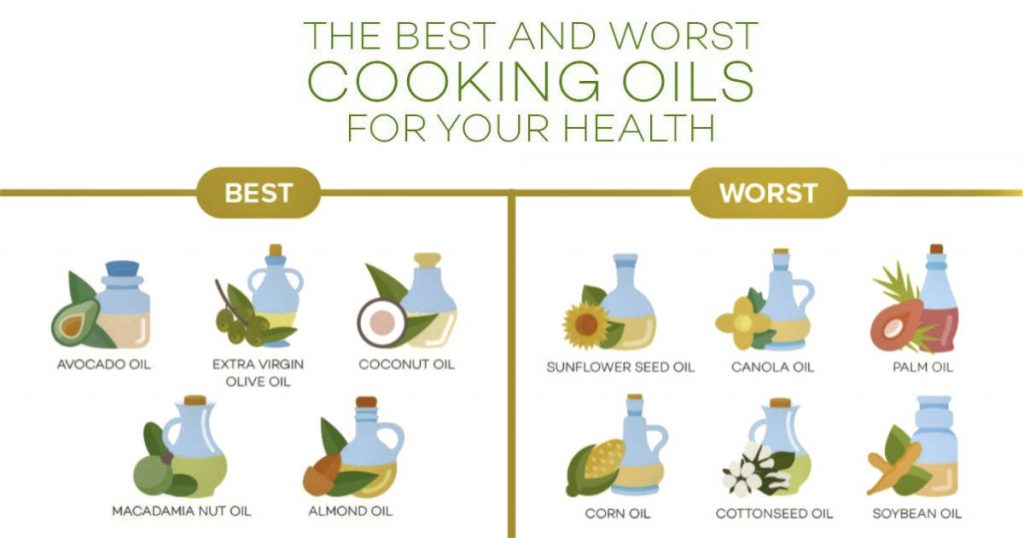
In nutritional truth, not all vegetables oils are created equal. The vegetable oils in this context refer to oils extracted from seeds, grains and legumes including soybean oil, corn oil, sunflower oil, safflower oil, canola oil, peanut oil, rice bran oil, grape seed oil, and cottonseed oil.
Vegetable oils, while nearly nonexistent a hundred years ago, now account for approximately 20% of our caloric intake. Food manufacturers who use these cheap oils for their commercial goods, have utilized it in nearly every packaged food product on the grocery shelf and fast food restaurant add them to the meals we eat, so expect to find them in just about everything from oat milk, tortilla chips, margarine and mayonnaise to Subway’s breads, Domino’s pizza crust and Chipotle’s rice.
Unfortunately, as consumption of these cheap vegetable oils have grown, so have the rates of obesity, cancer, and diabetes and recent studies are indicating there is a correlation between consuming these vegetable oils and devastating consequences on our wellbeing.
In the Sydney Diet-Heart Study, researchers separated study participants into two groups. Both groups consumed the same amount of fat and oil, but the first group’s fat came primarily from vegetable oil sources like safflower oil and margarine while the second group’s fat came from sources like olive oil and butter. Everything else about their diets and lifestyles remained unchanged.
Both groups were monitored and evaluated regularly for the next seven years. The group consuming more seed vegetable oil had a 62% higher rate of death during the seven-year study compared to the group eating less seed vegetable oil.
In another study, the Minnesota Coronary Experiment, participants who increased their consumption of corn oil and margarine had 86% more heart attacks, and for those aged 65 or older, a higher risk of death after four years.
Inflammation
As the food industry began to refine cooking oils, the omega-6 fats in these oils created a drastic imbalance in the modern diet, making us more vulnerable to diseases such as heart disease and cancer proving the adage of we are what we eat holds true.
When consuming subpar fats in these inexpensive oils, your cell walls also become subpar. So instead of being flexible and responsive to intercellular communication, cell walls become stiff and rigid. The more rigid the walls, the slower the cell functions and the more vulnerable the body becomes to inflammation. And while intermittent increases in inflammation are critical for survival during physical injury and infection, research revealed that certain social, environmental and lifestyle factors can promote systemic chronic inflammation (SCI) that can, in turn, lead to several diseases that collectively.
Smoke Point

The smoke point of an oil is the temperature at which it goes over the edge of safety and starts smoking.At that point, the oil reacts with oxygen to form harmful compounds releasing free radicals. You definitely don’t want to be consuming or breathing in these compounds because free radicals can injure your cells and your DNA.
Case in point is a particular nasty compound called HNE. This compound is linked to the pathogenesis of vascular diseases such as atherosclerosis, diabetes, and neurodegenerative disorders. And the compound doesn’t just disappear after use. In fact, the longer you heat the oil or reuse oil, like restaurants do, the more HNE accumulates and that spells serious trouble for your body.
Oil stability depends on saturation levels defined by the type of fatty acids they reflect. Oils with saturated fatty acids are the top choice for cooking on high heat, like coconut oil, clarified butter (ghee), butter and avocado oil. They are stable because chemically the fatty acids are tightly packed thereby they tolerate high heat.
When ‘refined’ appears on the label it indicates the oil does not have the combustible solids found in healthy oils. Oils with polyunsaturated fats like soybean, corn, canola, sunflower, and safflower are unstable fats – they’re not bound together. When using these oils for high heat food prep, they produce higher levels of free radicals that decimates the nutritional properties of the food while putting your health at risk.
A Word About Palm Oil
The $40 billion palm oil industry is notorious for wiping out rainforests, displacing indigenous peoples, spewing carbon into the atmosphere and driving the orangutan, the pygmy elephant and the Sumatran rhino toward extinction.
The palm oil industry is a major driver of deforestation of some of the world’s most biodiverse forests. Burning rainforests to make way for palm oil plantations not only causes greenhouse gas emissions but fills the air with dense smoke, causing respiratory problems for the people working and living in the area. Workers on the palm oil plantations are subject to forced labour and other abuses. These plantations feed into the supply chains of some of North America’s most famous food and cosmetic companies.
In 2020 the EU banned palm oil for use in biofuels out of a concern for global warming and the US is considering banning palm oil because of labour abuse.
Palm Oil is very high in saturated fat and is associated to heart disease, liver dysfunction, obesity and type 2 diabetes.
Please Read the Label. If the product uses palm oil put it back on the shelf. The planet and your body will thank you.
Certainly, there are likely many factors that contribute to today’s chronic disease and obesity epidemic. Sugar, pesticides, plastics, factory farms, refined carbohydrates, gluten, hyper-palatable junk food, iPhones, and television have all been accused of causing obesity and disease. We’re a long way off from being in agreement about the true causes of today’s largest health problems, but based on scientific evidence, vegetable oils seem to play a much larger role in the diseases of modernity than most realize.
In the long list of things we’ve gotten wrong and need to improve in order to get ourselves out of this chronic disease epidemic reducing vegetable oil consumption seems to be taking a lead position.
References:
https://www.cdc.gov/chronicdisease/about/index.htm
https://www.bmj.com/content/346/bmj.e8707
https://www.bmj.com/content/353/bmj.i1246
https://pubmed.ncbi.nlm.nih.gov/4100347/
https://academic.oup.com/jn/article-abstract/123/3/512/4723339
https://lipidworld.biomedcentral.com/articles/10.1186/s12944-020-01256-0
https://www.sciencedaily.com/releases/2020/01/200117080827.htm
https://www.nature.com/articles/s41591-019-0675-0